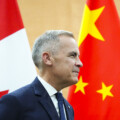The big question heading into the federal government’s release of the Fall Economic Statement was: just how big would the deficit be? Those bracing for the worst were pleasantly surprised, as Finance Minister Chrystia Freeland projected the deficit for 2023-24 would come in at $40 billion, in line with projections from Budget 2023.
But that doesn’t mean it was all good news. From the government’s continued “disastrous” bailout of the news industry to policies aimed at helping adoptive families, The Hub has gathered some of our smartest contributors to sort out the positive from the positively awful in the government’s statement.
The government dodged a fiscal bullet
By Trevor Tombe
I was wrong. But in a good way!
Despite significant headwinds from falling corporate tax revenues, lower oil prices, rapidly rising interest rates, mounting housing pressures, and demands for subsidies by various industries (such as for carbon capture), the federal government’s Fall Economic Statement avoided the higher deficit many anticipated. Including myself.
Just last week, I wrote that “the federal deficit will almost surely grow. A lot.”
Well. It didn’t.
In Budget 2023, the government anticipated a $40.1 billion deficit this year. In the update released on Tuesday, they updated this to…$40 billion.
The government dodged a fiscal bullet. At least this year.
How’d this happen? The fiscal pressures on the government are real. Corporate tax revenues are falling. Oil prices are lower. Interest rates are rising. And program spending in several areas is growing.
It turns out, though, that several important (and positive) developments spared the government from spilling any more red ink than was planned. But there’s a catch: these gains won’t last.
Rising sales taxes helped offset the decline in corporate income taxes. EI premiums were higher because employment was stronger. There was also $5.2 billion (!) in lower transfers to persons, largely as a result of higher recoveries of overpayments of COVID-related support programs. Altogether, there was nearly $3 billion in additional room, which covered all the planned spending increases.
Things look worse in the future, however. Higher inflation will boost future child benefits, OAS, and GIS (together by roughly $5.5 billion). And over the next five years, debt charges are expected to be nearly $22 billion higher than was in the budget. This means the deficit will indeed grow, but later.
While that’s potentially concerning, it’s worth noting that even this deterioration is modest. Anticipated federal debt will reach 40.2 percent of GDP in 2027–28, up from the 39.9 percent that the February budget expected. An increase, yes, but a rounding error.
One can certainly agree or disagree with the government’s overall approach to fiscal policy. Sean Speer, for example, recently made the astute observation that Harper-era taxes are potentially incompatible with Trudeau-era spending. And by not returning to pre-COVID debt levels sooner, we remain imprudently exposed to future calamities and economic disruptions.
But for those who were concerned about rapidly deteriorating federal finances (and I count myself among those who were), this fiscal update was a positive surprise.

What the FES means for the news
By Rudyard Griffiths
The news media asked for it and the government delivered it in the Fall Economic Statement. The yearly limit on labour costs that can be claimed per employee engaged in news production was increased from $55,000 to $85,000 and the tax credit rate was bumped up from 25 percent to 35 percent for four years. This will apply to all news outlets that have received “Qualified Canadian Journalism Organization” status as adjudicated by Revenue Canada. While who exactly is a QCJO is not public information, this group likely includes pretty much every mainstream media outlet in the country from The Global and Mail to The Toronto Star to Postmedia. The CBC is not eligible for the per-employee tax credit.
The rationale for the increased subsidy is that half or more of the annual funds earmarked five years ago for tax credit were going unclaimed due to the precipitous drop in the number of journalists employed by a dwindling number of CRA-qualified news organizations. In short, this is another not insignificant step towards a near-term future in Canada where private news media organizations could become majority government-funded, at least in terms of their journalistic output.
The generous bump up in the tax credit could also suggest that the government’s negotiations with Google may not be going well with regard to the Online New Act and its demand that the platform enter into either voluntary or CRTC-imposed agreements with news outlets to pay them for their content. Increasing the government’s direct subsidy to news organizations could be a pre-emptive measure to head off the sharp reduction in ad revenue that would result from Google following Meta’s example and exiting news sharing in Canada in order not to be subject to the Act. Time will tell but only a few weeks remain for Google to make a final determination if it will comply with the Act. Either way, the future of news in Canada looks increasingly uncertain as both public subsidies ramp up, further undermining public trust in the objectivity of mainstream media, and as the platforms make highly consequential decisions about the future of their role in news sharing online.
Trudeau’s political problem is bigger than his debt problem
By Theo Argitis
Prime Minister Justin Trudeau’s government has faced plenty of criticism over its fiscal management over the past three years and the debate won’t be settled by Tuesday’s budget update.
Putting aside the medium-term trajectory (which should be discounted) and focusing on the very near-term numbers, the fiscal economic statement reinforces the idea that Trudeau and his finance minister, Chrystia Freeland, have settled into a sort of equilibrium in their budget math.
The governing Liberals appear to be happy running structural deficits just north of 1 percent of GDP, with spending and revenue at more elevated levels than we’ve seen over the past 20 years but not off the charts.
Critics will point out the federal government has left itself vulnerable to macroeconomic shocks, with the surge in debt narrowing its scope to tackle new future challenges. Which is true.
But the budget numbers are still manageable as long as at least three conditions are met: inflation and interest rates return to more normal levels, the economy grows at a decent pace and the Liberals temper their ambitions.
In other words, we should be fine as long as we get a soft landing for the economy along with a change in governing philosophy for the Liberals. Both are to be determined.
The soft-landing assumption—while not exactly the most prudent in a world of elevated and increasing uncertainty—is at least the prevailing view in financial markets and among private sector economists.
The second assumption—whether the Liberals can resist using fiscal levers and growing the state further from here—is perhaps a bigger question, particularly as elections approach.
What the budget numbers have shown so far this year is a government gradually being hemmed in by a combination of slowing (albeit decent) growth in revenue, rising debt costs, and inflationary concerns.
The history of Freeland’s budgets since 2021 has been to use stronger than expected windfall revenue (in part because of inflation) to finance an expansionist agenda—both in terms of social policy and climate change. But it appears the era of loose budget constraints has come to an end.
How well Trudeau and Freeland navigate this fiscal landscape will hinge on how ambitious they want to be from here.
Trudeau doesn’t have a debt problem, yet. But he definitely has a political problem.
The government surpassed our low expectations—but pitfalls remain
By Sean Speer
The Hub’s resident economics commentator (and in my mind the best in the country) Trevor Tombe described this week’s Fall Economic Statement as a “positive surprise.” It is true that this year’s deficit projections didn’t grow as expected. But we shouldn’t let low expectations shape our analysis.
The government’s deficit projections are worse in the subsequent four years such that its cumulative deficits over the next five years are actually $35.9 billion higher than in the March budget (see the table below). It’s not that long ago that a 27-percent increase in Ottawa’s deficit projections over a five-year horizon would have been a big deal—especially if it happened in less than eight months in the absence of a major economic downturn or some other calamity.
| 2023-24 | 2024-25 | 2025-26 | 2026-27 | 2027-28 | |
| 2023 Budget | 40.1 | 35.0 | 26.8 | 15.8 | 14.0 |
| 2023 FES | 40.0 | 38.4 | 38.3 | 27.1 | 23.8 |
| Difference | 0.1 | -3.4 | -11.5 | -11.3 | -9.8 |
The deficit is now projected to remain essentially unchanged over the next three years and there’s good reason to believe that the risk is to the downside. Does anyone really assume that the Trudeau government won’t increase spending further over this period as it heads into another election? Does anyone really assume that it won’t increase spending three months from now in the 2024 budget? The answer to both questions is surely no.
The upshot: we’ll almost certainly see further backsliding as early as March 2024. The deficit will invariably once again grow and our expectations will similarly need to be lowered once more.
As for the rest of the Fall Economic Statement, it wasn’t all bad. There were some individual measures that are worthy of support.
My favourite is the creation of a new 15-week Employment Insurance benefit for adoptive parents that should find support among gays and lesbians and pro-life conservatives alike. It creates greater convergence between the policy treatment of adoptive and biological parents and recognizes the unique particularities that the former faces in welcoming a non-biological child into their home. This is good and compassionate public policy that should have happened a long time ago.
I’m also hopeful about the commitment to move forward with permitting reform for major projects, including “clarifying and reducing timelines, mitigating inefficiencies, and improving engagement and partnerships.” Although it’s possible that any eventual reforms prove to be underwhelming, there is a counterintuitive world in which the Trudeau government’s climate change ambitions actually make it uniquely positioned to advance such a regulatory reform agenda.
One policy proposal that I’m a bit concerned about though is the so-called Canadian Mortgage Charter, which according to the Fall Economic Statement, would set out the expectation that financial institutions must grant mortgage holders “fair, reasonable and timely mortgage relief measures” if they face difficulties on managing the costs of their primary residences.
I understand and even sympathize with the motivation here. I even accept that there may be a need for some kind of short-term dispensation so that we don’t have a massive problem in the next two years involving households who can no longer afford their homes in a higher interest rate environment.
But even then, one cannot help but feel a bit anxious about Ottawa insisting that the banks adopt a series of programs and policies unrooted from basic economics. That is essentially the story of the U.S. housing crash in 2007 and the global financial crisis that it eventually precipitated.
The medium-term goal must be to minimize the extent to which government policy is pushing people into homes that they cannot afford so that we don’t need subsequent government policies to help them when they cannot afford them.
Indigenous peoples can be cautiously optimistic about the FES
By Karen Restoule
Economic reconciliation supporters across Canada were pleased to (finally) see the federal government commit to the introduction of a national Indigenous loan guarantee program as part of their 2023 Fall Economic Statement. Challenges in accessing capital, a result of limitations put in place by the Indian Act, have been at the centre of advocacy efforts for several years. It is a key issue that led some First Nations to join forces in 2017 to create the First Nations Major Projects Coalition, a collective that has been advocating on behalf of their growing membership for the creation of a solution. According to the announcement, details about the program will be shared in Budget 2024. Let’s hope it respects the self-determination of Indigenous peoples, a sentiment repeatedly expressed by this federal government, to determine which industry projects suit them best—including those in oil and gas.
It is an understatement to say that Canadians across the country were particularly anxious to hear about measures and investments that would be made by Minister Freeland to address affordability and housing challenges. This sentiment was shared by Indigenous peoples, as well, whether they are living on- or off-reserve. Indigenous housing providers welcomed the reaffirmation of the implementation of the Urban, Rural, and Northern Indigenous Housing Strategy announced in Budget 2023 which will see the distribution of $4 billion in 2024. While it may seem like a bigger chunk of change, it responds to a portion of the need. Indigenous peoples represent 39 percent of shelter users in 2021 while making up a mere 5 percent of the Canadian population.
The need, coupled with a commitment to a “for Indigenous, by Indigenous” approach, means this federal government would be wise to work with Indigenous housing leaders who are experienced in implementing solutions for results—such as those who are involved in NICHI, the National Indigenous Collaborative Housing, a collective of Indigenous housing providers who joined forces on the principle of cooperation with a desire to channel their collective expertise and experience to ensure that no Indigenous person living off-reserve gets left behind.
While we should remain consistently hopeful that any federal government will budget for initiatives that lead to tangible results and move the “Quality of Life Yardstick” forward for Indigenous peoples, we ought to proceed with guarded optimism. While this federal government has shown itself to be skilled at spending, the Parliamentary Budget Officer showed us in his 2022 report that when it comes to government deliverables impacting Indigenous peoples, targets are not achieved.
All the more reason to move ahead expeditiously with the implementation of a sector-agnostic national Indigenous Loan Guarantee Program—because we know that Indigenous equity participation in projects in their own territories leads to strengthened local economies and subsequently, a stronger social fabric.
The FES will do little to help the Liberals in the polls
By Taylor Jackson
It’s no doubt been a tough few months for the federal Liberals. They’re down more than 10 points in the polls, and economic anxiety is high across the country. If an election were held today, the likely result would be a blue wave and Conservative majority. Releases like yesterday’s FES offer important opportunities for governments to reset narratives and tell the story they want voters to hear. Yet, if one of the goals of the latest Liberal economic plan was to stem the tide of the Conservatives, it’s hard to see how it will accomplish that end.
Moving forward, the federal Liberals have a major communications problem. There are at least two parts to this. First, the Liberals need to empathize with Canadians who are going through economic hardship. People don’t want to be patronized, but they at least want some sense that their governments can understand some of what they’re going through. While the government tried to do this at some points in the minister’s speech and subsequent interviews, other parts fell flat, sounding more like the platitudes one finds on Liberal Twitter. Canada may have been a leader in inward FDI in the first part of the year but does your average Canadian care (if they even know what FDI is) when people are struggling to put food on the table, with food bank visits being up 51 percent year-over-year. Or when Canadians don’t know if they will be able to afford their rent or mortgage payment next month. Minister Freeland emphasized in her speech that “Canada is not and has never been broken.” Maybe Canada is not “broken,” but something is certainly off. The challenge for the Liberals will be empathizing with voters who feel that way, and not making it seem like they live in a different world.
“The federal Liberals have a major communications problem.”
The second challenge for the Liberals is the need to convince Canadians that their measures are going to help them in tough times. It is hard to see how many of the affordability initiatives in the FES will make much of a material difference in the cost of living for Canadians. If the Liberals were serious about housing affordability, the one policy lever they explicitly control is immigration. However, the government plans on making no changes to permanent or temporary migration levels. As for the other affordability measures, they appear far more rhetorical than substantive.
Adoptive parents will be heartened by the FES
By Peter John Mitchell
While the affordability theme has garnered headlines, here’s something we could easily miss: the Fall Economic Statement makes good on a previous directive from the prime minister to establish a new 15-week leave benefit for adoptive parents.
Adoptive families qualify for parental leave benefits but are ineligible for the 15-week maternity leave benefit. The new adoption benefit mirrors the length of the maternity benefit but differs in that it can be shared between parents. The government estimates the cost to be $48.1 million over six years with an additional $12.6 annually after that.
The Adoption Expense Tax Credit is the primary federal program that assists adopting families. Adoption is a provincial issue with regional governments offering support for adopting families. Federal policymakers should be cautious about introducing large-scale programs that infringe on provincial responsibilities, but the new benefit is a modest expenditure that signals the importance of adoption and recognizes the critical role of parent-child attachment in healthy child development.
Another directive within the Fall Economic Statement that could benefit adoptive families is the removal of the GST/HST from psychotherapy and counselling. I recently spoke with the head of an adoption agency who described the massive gap in post-adoption support for families. She described how grief and loss are part of every adoption story, and that these issues can surface years after an adoption. Regardless of whether removing tax from counselling services actually does anything to increase the availability of mental health services for Canadians, it at least signals the importance of these services.
It is true that the federal government is the furthest removed institutional support in the life of adopting families. Still, the employment insurance adoption benefit extends help the federal government already offers most families while affirming the importance of parent-child attachment.
Thankfully, price controls on groceries are still a no-go
By Andrea Mrozek
With parents who left the Czech Republic in 1969, the theme of scarcity was an undercurrent through my formative years. To be clear, my family in Canada did not experience it. But it was apparent that my relatives back in Europe could not say the same. We visited Poland (the Czech Republic was not yet allowing ex-pats in) in summer 1989 before the fall of the Berlin Wall and I witnessed firsthand empty storefronts. I remember seeing just a couple of onions rolling around on otherwise empty grocery store shelves.
All the discussion, therefore, of high grocery prices with the lion’s share of blame placed on the business owners who provide our groceries has made me a bit nervous. Yes, grocery prices are notably higher, and yes, even our well-off family makes decisions about what not to buy. There’s been plenty of pressure for grocery prices to go down—but when governments talk about that, what can they do?
In another domain, child care, they’ve decided to lower costs by appropriating private businesses in slow motion. Private daycare operators who have mortgaged homes to have a lease for child care centres have their backs against the wall as government regulations courtesy of the new Canada-wide Early Learning and Child Care plan strangle the businesses they have built.
Cost controls in that area are introducing ever greater shortages, too.
Thankfully, for groceries, the government will not take that approach. Instead, they will “enhance competition in the grocery sector.”
Scarcity, bread lines: for many immigrants and their children, these problems are not a far away history. These economic conditions are perfectly possible with the wrong policy here, too. Thankfully, it seems in this economic update the government understands this, at least for grocery prices.
The government bails out the news media in an unmitigated policy disaster
By Michael Geist
The government has taken the first step to creating a bailout for its disastrous Bill C-18 by agreeing to News Media Canada demands to increase the support under the Labour Journalism Tax Credit. While the current system covers 25 percent of the journalist costs up to $55,000 per employee (or $13,750), the government’s fall economic statement increases both the percentage covered and cap per employee. Under the new system, which is retroactive to the start of this year, Qualified Canadian Journalism Organizations (which covers print and digital but not broadcasters) can now claim 35 percent of the costs of journalist expenditures up to $85,000 per employee. The increases the support to up to $29,750 per employee or an increase of 116 percent. This new support will run for four years at a cost of $129 million ($60 million this year alone).
Despite the huge increase and the growing dependence on government support for the news sector, this bailout should not come as a total surprise. Notwithstanding the tough talk, Bill C-18 has been an obvious and unmitigated disaster, resulting in lost traffic and revenues for Canadian news outlets who did not take the prospect of blocked news links on Facebook and Instagram seriously. If blocked news links extends to Google—a decision will presumably be forthcoming in the next month—the effect will be catastrophic to the Canadian media sector. News Media Canada, which was the lead lobbyist for Bill C-18, became the lead lobbyist for a bailout this past summer. As I wrote back in September, the organization was demanding—wait for it—an increase to 35 percent of costs at $85,000 per employee. In other words, the government gave the lead news media lobbyist in Canada precisely what it demanded.
This raises enormous concerns about the independence of Canadian media. While the government claims this is being done to ensure a “strong and independent” press, it is not hard to see how the opposite may be true. Canadian media was already reluctant to hold government to account on Bill C-18 and now it finds that more than one-third of its labour costs for journalists are effectively paid by the government. Indeed, this inches Canadian news outlets ever closer to the CBC, particularly if government legislation is able to extract even more support from external sources such as Google.
I warned back in August that a government bailout was the likely next step given the epic miscalculation of Bill C-18, writing:
The third and most worrisome course of action would be for the government to bail itself out of the Bill C-18 mess by using public money to compensate for the losses that it triggered. But a bail out for its miscalculation should be a non-starter as it would mark a huge government intervention into the media sector and result in the public directly funding media at an unprecedented level that call into question its very independence.
That has indeed come to pass, ultimately leaving the Canadian media less independent and the public spending over $100 million for the mistaken hubris of Pablo Rodriguez, Pascale St-Onge, and the entire Trudeau government.
This analysis originally appeared at www.michaelgeist.ca.
Recommended for You

Carney’s potential visit with Xi Jinping will expose Canada’s major trade-security tensions with China

‘Propaganda?’: A government of Canada campaign hopes to win hearts and minds

‘China taking tariffs off doesn’t solve the problem’: What a potential Carney-Xi meeting means for Canada-China relations

Build Toronto aims to make a worn-out city world-class



